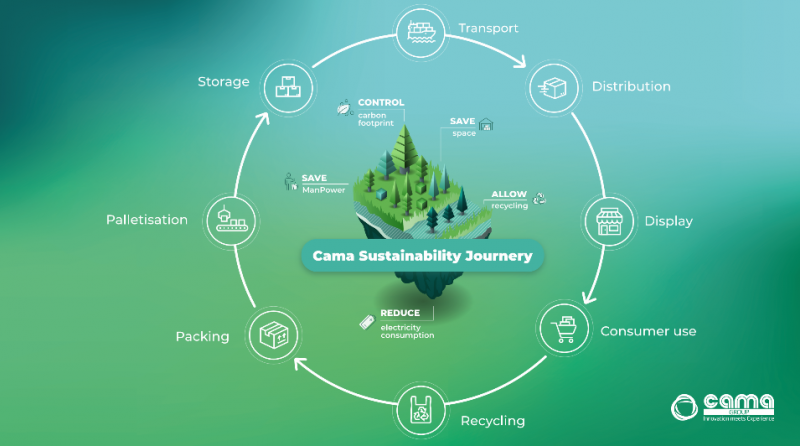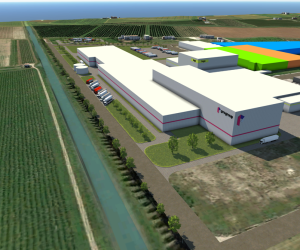

Sustainability: Its essential to look at the bigger picture
Mark Brooker, Director of Cama UK Ltd., looks into sustainability in the packaging industry and explains that it’s not just about the machines, it’s about the entire ethos of a company and what it can deliver to its customers.
With all the talk of operational data and digital transformations dominating today’s headlines, engineers must not lose sight of the bigger picture; especially regarding other operational targets and programmes – one of which is sustainability.
“Sustainability is not, and never was, a short-term fad,” explains Mark Brooker, Director of Cama UK Ltd. “It should be considered as an ongoing company-wide programme that forms, if not the basis, then a primary deciding input, into some of your biggest operational decisions. Companies must learn to strike a balance – ensuring that their business aspirations do not impact the guidelines and targets of sustainability programmes. We all have a responsibility as individuals, teams, companies and corporations to ensure that we are as ‘green’ as possible in everything we do.
“From my own experiences, Cama Group has a cradle-to-grave sustainability programme, which I think many companies would be proud to emulate. We don’t just look at our machines and how they operate, we look at the bigger picture, which includes everything from our premises to a product’s end of life.
“If we start at the very foundations of the company,” he continues, “our new HQ in Italy boasts multiple energy-saving aspects, including intelligent lighting systems, advanced HVAC, glare & shading solutions and solar panels on the roof. We also deploy e-mobility solutions, which not only cut down pollution, but also give employees and visitors places to charge electric cars.”
Cama is certified UNI EN ISO 9001/UNI EN ISO 14001/OHSAS 18001 in the field of automatic packaging machinery and systems and robotics. The certifications, issued by SQS (the Swiss association for Quality and Management Systems), one of the highest reputation certifying boards in the world, cover sales, design and production of packaging machines, after sales and spareparts service, safety and environment. The ISO certifications guarantee Cama’s high quality in the manufacturing process, in the choice of materials, in the internal work organization and in pursuing constant development and improvements, in full respect of environment.
All of Cama’s activities regarding environment, labour practices, fair business practices and sustainable procurement have also been evaluated by EcoVadis, the international platform which comprehensively assesses Corporate Social Responsibility (CSR). Awarded the Silver Rating, with an overall score of 56 points, Cama’s activities rank far above the average. Indeed, only 11% of all general-purpose machinery manufacturers, evaluated by EcoVadis, reach this score. Within the theme of Sustainable Procurement, Cama is in the top 5% of all the companies ranked.
An eco HQ and international certifications are certainly impressive features for a company brochure, but it is the ability to pass on sustainable concepts and procedures – in the shape of advanced machine designs – that play a bigger role. After all, it is the in-field operations that can potentially have the biggest impact.
“Our customers are just as committed as we are, in this aspect. Indeed, a machine’s design and its subsequent operational life have huge roles to play in sustainability programmes,” Brooker explains. “A key element in the design of our secondary packaging solutions is low energy use, and this has been a staple part of our design philosophy for the last 10 years. It’s all to do with designing out inefficiencies. We keep pneumatics to an absolute minimum and use low-energy drives wherever possible; but cutting power consumption is just half the story.
“Companies also need to look at the physical designs of their machines,” he continues. “A great example from within Cama is our BTG (Breakthrough Generation) and Monobloc machines, which utilise integrated cable-management solutions. These not only cut down on cabling, but also remove the need for many of the ancillaries, such as clips and fastenings. Co-located control panels also reduce the need for extensive wiring looms, as does our integrated in-house developed robotic platform, which does not require a separate controller… simply running off the primary PLC.
“Cleanliness is an essential element, too,” he adds. “By removing trap points and promoting easy run off and internal access, companies can cut their clean-in-place routines down, not just in terms of time, but also water use and cleaning consumables. In the same vein, sealed for life bearings and self-lubricating chains and guides also cut maintenance and consumables.
“It would be remiss of me, especially in the current climate, not to look at the impact that digital transformations and the IIoT have had on operations,” Brooker explains. “A primary target of connected and data-capable control solutions is the attainment and management of KPIs, most of which are performance and quality based. By connecting our machines to wider-enterprise management solutions, monitoring suites can spot peaks and troughs and address them before they have any impact on the KPI metrics. Although this is a very operational-centric approach, the resulting fallout of this monitoring is less wastage, better quality, proactive maintenance and greater efficiency, all of which help towards a sustainability programme. A stitch in time saves nine, if you like.
“In terms of proactive maintenance, data has a bigger role with today’s machines,” he adds. “As artificial intelligence systems evolve, more advanced and intelligent proactive maintenance solutions are becoming available that will deliver precision application-/machine-specific maintenance, rather than ‘what ifs’. How do you know that a component sending spurious data actually needs to be replaced (at great cost and materials)? It may last much longer than you anticipate, making costly knee-jerk replacements unnecessary. Cama’s Industry 4.0 solutions are delivering these benefits today.
“Contemporary data architectures also give companies the scope to adapt existing plant to cater for changing market and industry demands,” Brooker elaborates. “By using flexible architectures and servo solutions, we have the ability to future proof our designs, allowing our customers to adapt their machines as trends evolve. This architecture also means modifications can be achieved with far less engineering effort and expenditure, resulting in huge savings in the long run.”
In terms of actual product handling, media compatibility and operational capabilities, machine design plays a vital role, too. “Our machines utilise positive handling. This approach ensures that each product is handled individually and faces far less contact on its journey through the machine. Not only does this result in greater shelf appeal, but there is also less wastage due to damaged products. From a materials perspective, we have specialised in paper-based packaging for decades, with our history starting in sleevers,” Brooker explains. “Paper and card’s closed-loop supply chain make them an obvious ‘eco-avenue’ for companies to go down with ethically managed forestry and full chain of custody credentials, paper-based substrates provide clear sustainability benefits. There are certainly many proven and mature solutions on the market, but in some cases, plastic is still a necessary candidate for barrier protection requirements at low cost. We have this covered, too, as we have just installed machines for a leading dairy company that can handle 100% mono-material (PET) packaging for the cup, label and lid, ensuring suitability for modern recycling systems. There were numerous hurdles to overcome, but we anticipate huge demand for this technology and not just from the customer who has recently expanded the order.”
Packaging materials also have a huge part to play in packaging styles and designs. Shelf appeal and robustness are obviously high up the scale, but there is no reason why sustainability cannot also be part of the equation. “We have a packaging design team at Cama,” Brooker adds, “which helps customers realise their final designs. Aesthetics and functionality form the primary brief, but we can also advise on materials usage and designs that promote less wastage, reduced ‘over designing’ and more efficient material use through nesting and optimised palletisation, resulting in lower total costs. “As you can see, sustainability is not just about how fast the electricity meter spins round,” Brooker concludes. “Companies have to take a holistic approach and look at every single facet of not only their operations, but also how their machines, products and technology work at their customers. Without this sort of joined-up thinking, which literally goes from cradle to grave, sustainable messaging just becomes lip service to appease share holders and environmental practitioners.
For further information go to www.camagroup.com





